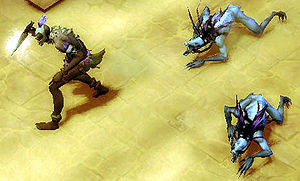Summon Zombie Dogs
Summon Zombie Dog is a tier I Witch Doctor skill.
This is the basic minion skill of the Witch Doctor. It summons several zombie dogs, better known as "mongrels" which tank for the Witch Doctor.
Mongrels can also be detonated by the Sacrifice skill, dealing substantial damage to anything in the vicinity. This is their most effective way of directly damaging monsters.
Contents
Background
| Diablo III Skill [e] | |
|---|---|

| |
| Summon Zombie Dog Active, 5 ranks | |
| Used by: | Witch Doctor |
| The Witch Doctor summons a zombie dog to aid him. Can have multiple zombie dogs at once. | |
| Type: | Summon |
| Quantity: | Cast |
| Effect: | Target |
| School: | Magical |
| Health cost: | 10 health |
| Cast time: | Unknown |
| Duration: | None |
| Cooldown: | Unknown |
| Synergies: | Unknown |
| Requires: | N/A |
| Prereq of: | N/A |
More points in the skill allow for more, higher level mongrels. They have good foot speed and are fearless, if not very damaging with their hand to hand combat. Sacrifice deals far more damage than the mongrels every will.
Skill Design
Summon Zombie Dog is the first summoning skill most Witch Doctors will ever use, and forms the backbone of early Witch Doctor strategy. The dogs are not very strong individually, either in giving or taking damage, but they are effective meat shields for the Witch Doctor to use his attack spells from the back row.
At higher levels Mongrels can deal decent damage, and in a swarm they may be useful against individual enemies, especially when their damage is boosted by a runestone.
Enhancing the Dogs
Earlier in Diablo III's development, the Witch Doctor's fire and Locust spells could jump to the Mongrels, granting them fire or locust damage on top of their own (weak) attacks. This feature was removed in 2009, and later replaced by various runestone effects.
Skill Rank Table
Figures as observed in the Blizzcon 2009 demo. They will differ in the final game.
- Rank: 1/5
- Summon 1 level 12 zombie dog to aid you. Can have up to 1 zombie dogs at a time.
- Health Cost: 10 health
- Rank: 2/5
- Summon 1 level 12 zombie dog to aid you. Can have up to 2 zombie dogs at a time.
- Health Cost: 10 health
- Rank: 3/5
- Summon 1 level 12 zombie dog to aid you. Can have up to 3 zombie dogs at a time.
- Health Cost: 10 health
- Rank: 4/5
- Summon 1 level 12 zombie dog to aid you. Can have up to 4 zombie dogs at a time. (A)
- Health Cost: 10 health
- Rank: 5/5
- Summon 1 level 12 zombie dog to aid you. Can have up to 5 zombie dogs at a time. (A)
- Health Cost: 10 health
(legend (A) = Assumed)
Synergies
Various Witch Doctor traits boost his spell damage and casting speed across the board, as well as increase damage to particular monster types. Several traits grant bonuses more specific to the Mongrels, though.
- Leader of the Pack -- +5% damage to Zombie Dogs.
- Unrelenting Assault -- 10% chance that a Zombie Dog will be brought back to life when it dies.
- Spirit Link -- 10% of damage taken is instead redirected to your summons.
- Plagued -- Increases damage done by Animal and Plague skills.
- Ferocity -- Increases damage done by your summons.
- Care of the Master --Increases the health of your summons.
Runestone Effects
A few of the Mongrel runestone effects have been revealed.
- Crimson rune -- Level 2 rune effect: Zombie dogs share 20% of the damage the Witch Doctor takes.
- Another unidentified rune effect gave the mongrels substantial fire damage.
- Another one gives mongrels a chance to drop a health orb when they die. (It's not known if Sacrificed dogs would also qualify for this. If so, given that there are traits enable mana gain from health orbs, it could be largely self-sustaining.
Development
Summon Zombie Dog was seen in every Diablo 3 game demo to date, and was iterated, renamed and moved, judging from the latest demo. The Summon Zombie Dog was called Summon Mongrel (as Mongrel was the original name of the Zombie dog), was in the Voodoo skill tree and mongrels could be enchanted with Locust Swarm or Skull of Flame.
Media
You can find pictures in the Diablo 3 screenshot and picture gallery:
References


